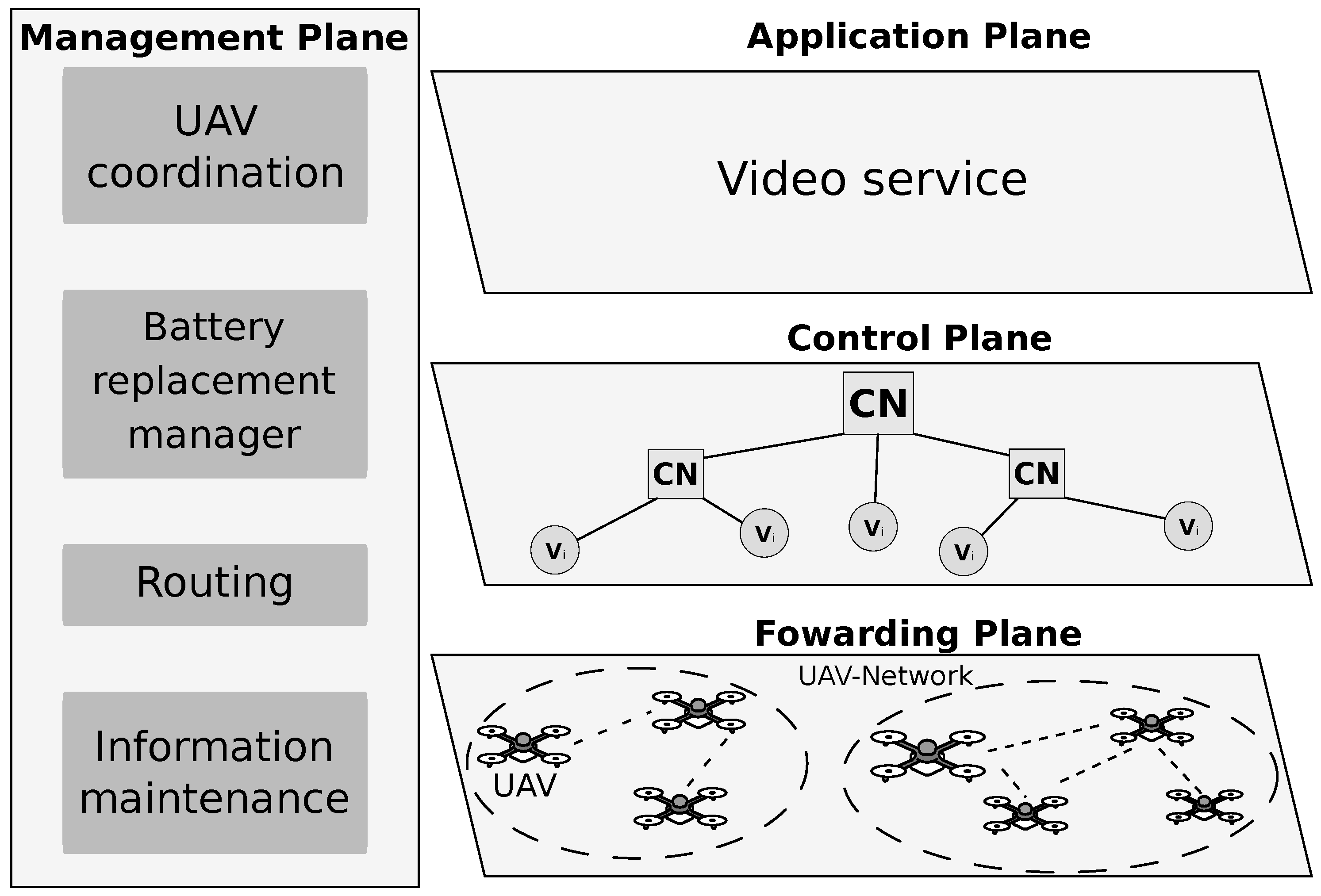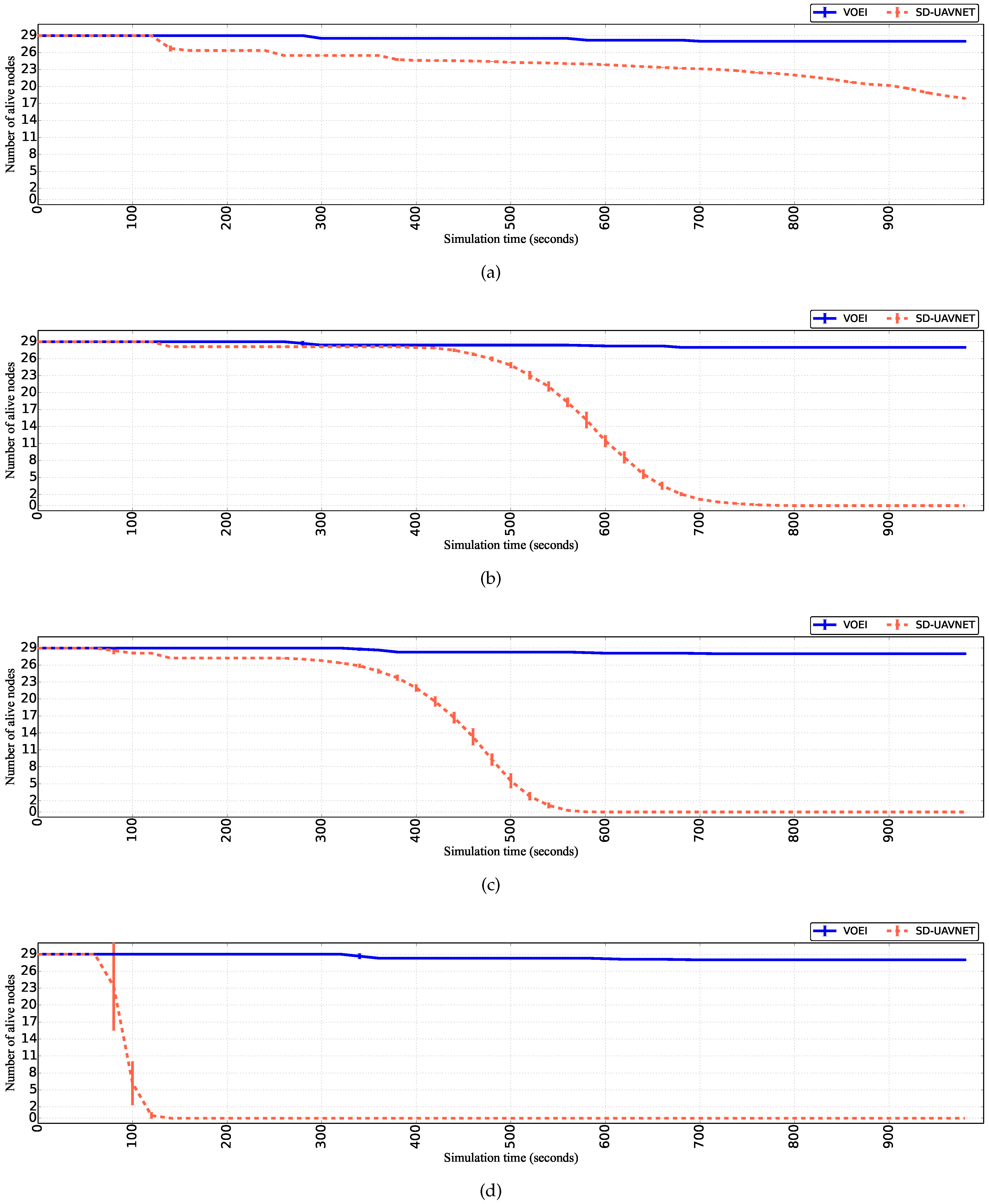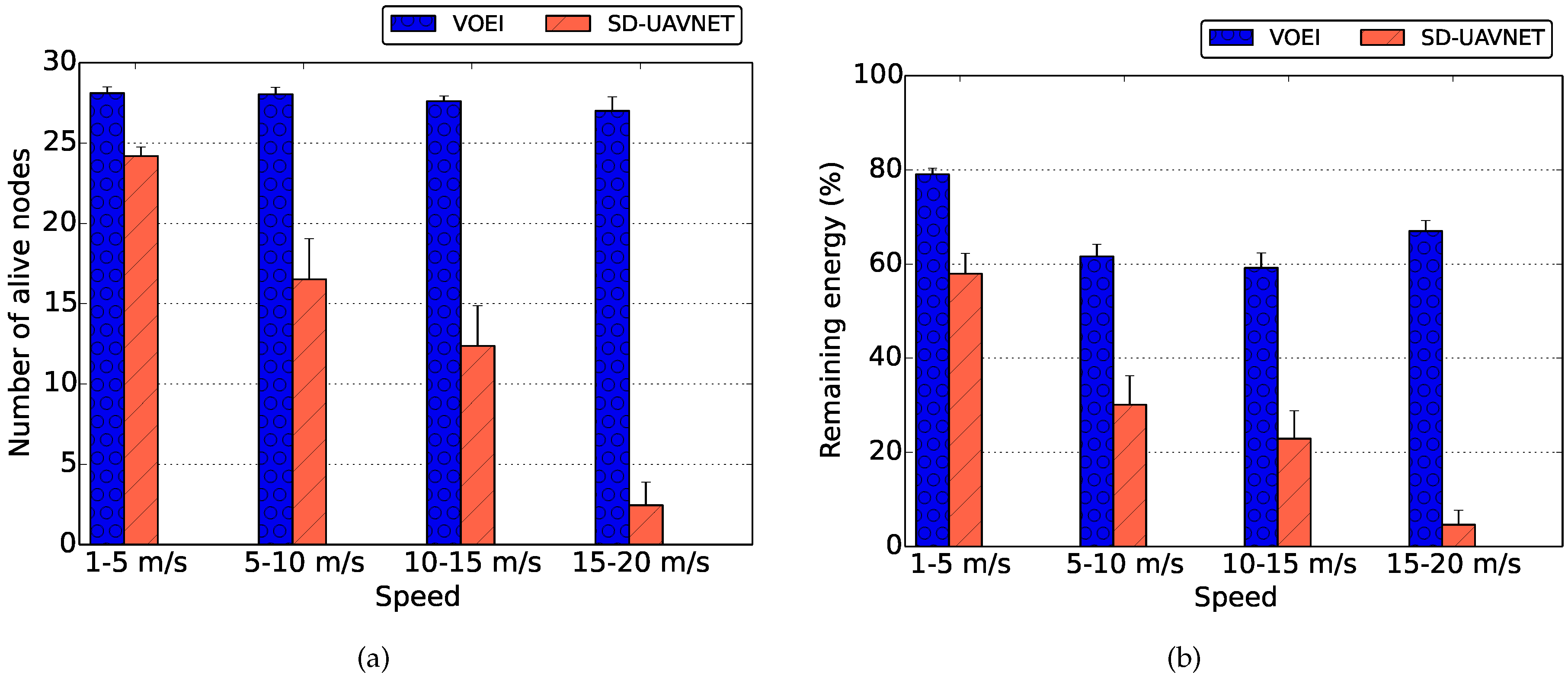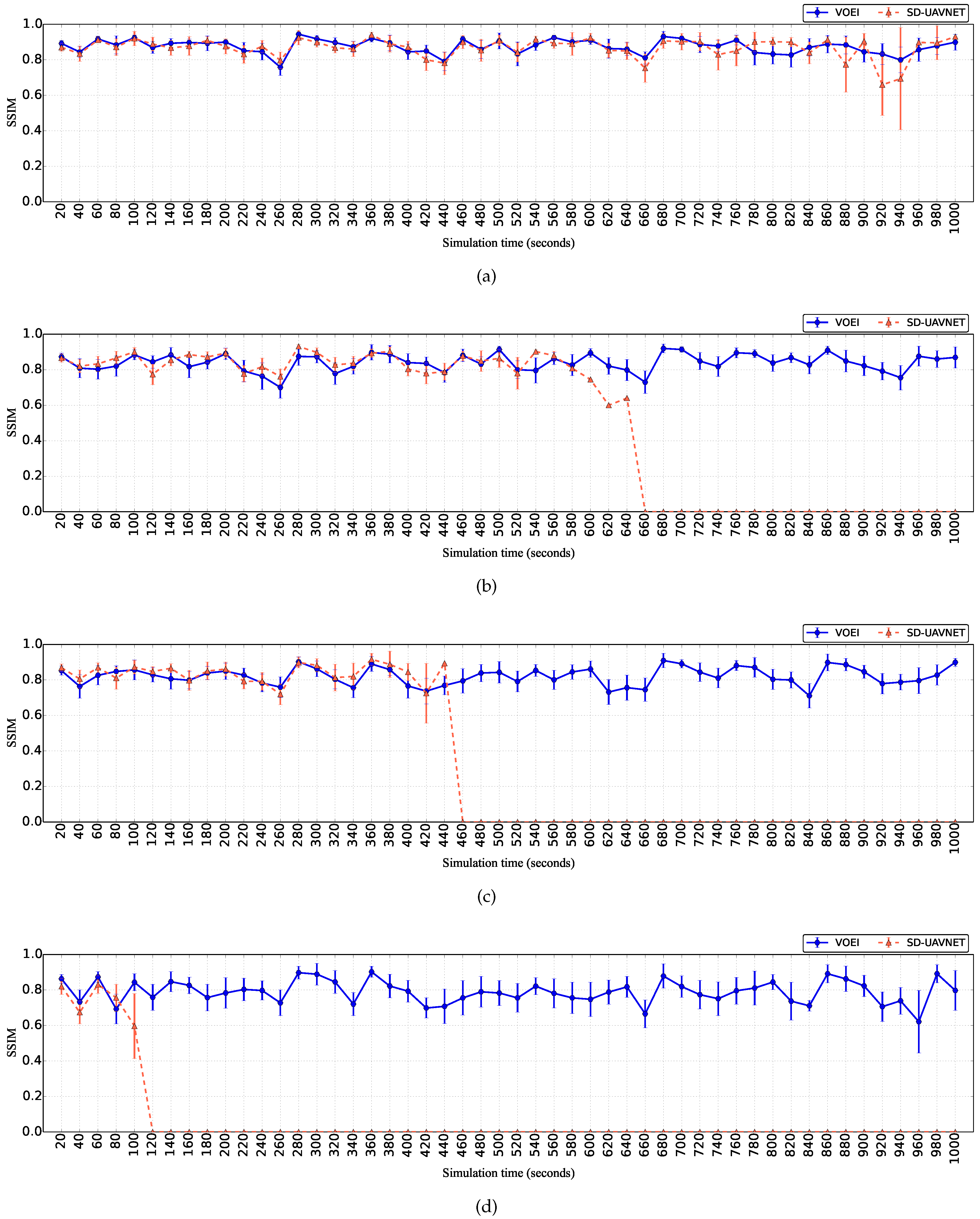Cooperative UAV Scheme for Enhancing Video Transmission and Global Network Energy Efficiency
Abstract
:1. Introduction
2. Related Work
3. Cooperative UAV Scheme for Enhancing Video Transmission and Global Network Energy Efficiency (VOEI)
3.1. Network and System Model
3.2. VOEI Operation
3.2.1. Route Establishment
3.2.2. UAV Replacement
4. Evaluation
4.1. Simulation Description and Metrics
4.2. Simulation Results
5. Conclusions
Author Contributions
Funding
Conflicts of Interest
References
- Bekmezci, I.; Sahingoz, O.K.; Temel, Ş. Flying Ad-hoc Networks (FANETs): A Survey. Ad Hoc Netw. 2013, 11, 1254–1270. [Google Scholar] [CrossRef]
- Zeng, Y.; Zhang, R.; Lim, T.J. Wireless Communications with Unmanned Aerial Vehicles: Opportunities and Challenges. IEEE Commun. Mag. 2016, 54, 36–42. [Google Scholar] [CrossRef]
- Yanmaz, E.; Yahyanejad, S.; Rinner, B.; Hellwagner, H.; Bettstetter, C. Drone networks: Communications, coordination, and sensing. Ad Hoc Netw. 2018, 68, 1–15. [Google Scholar] [CrossRef]
- Gupta, L.; Jain, R.; Vaszkun, G. Survey of Important Issues in UAV Communication Networks. IEEE Commun. Surv. Tutor. 2016, 18, 1123–1152. [Google Scholar] [CrossRef]
- Rosário, D.; Zhao, Z.; Santos, A.; Braun, T.; Cerqueira, E. A Beaconless Opportunistic Routing based on a Cross-layer Approach for Efficient Video Dissemination in Mobile Multimedia IoT Applications. Comput. Commun. 2014, 45, 21–31. [Google Scholar] [CrossRef]
- Liotou, E.; Tsolkas, D.; Passas, N.; Merakos, L. Quality of Experience Management in Mobile Cellular Networks: Key Issues and Design Challenges. IEEE Commun. Mag. 2015, 53, 145–153. [Google Scholar] [CrossRef]
- Ferranti, L.; Cuomo, F.; Colonnese, S.; Melodia, T. Drone Cellular Networks: Enhancing the Quality of Experience of Video Streaming Applications. Ad Hoc Netw. 2018, 80, 130–141. [Google Scholar] [CrossRef]
- Maia, O.B.; Yehia, H.C.; de Errico, L. A Concise Review of the Quality of Experience Assessment for Video Streaming. Comput. Commun. 2015, 57, 1–12. [Google Scholar] [CrossRef]
- Erdelj, M.; Saif, O.; Natalizio, E.; Fantoni, I. UAVs that Fly Forever: Uninterrupted Structural Inspection Through Automatic UAV Replacement. Ad Hoc Netw. 2017. [Google Scholar] [CrossRef]
- Mozaffari, M.; Saad, W.; Bennis, M.; Nam, Y.H.; Debbah, M. A Tutorial on UAVs for Wireless Networks: Applications, Challenges, and Open Problems. arXiv. 2018. Available online: https://arxiv.org/abs/1803.00680 (accessed on 27 November 2018).
- Zhao, Z.; Cumino, P.; Souza, A.; Rosário, D.; Braun, T.; Cerqueira, E.; Gerla, M. Software-Defined Unmanned Aerial Vehicles Networking for Video Dissemination Services. Ad Hoc Netw. 2019, 83, 68–77. [Google Scholar] [CrossRef]
- Wickboldt, J.A.; De Jesus, W.P.; Isolani, P.H.; Both, C.B.; Rochol, J.; Granville, L.Z. Software-Defined Networking: Management Requirements and Challenges. IEEE Commun. Mag. 2015, 53, 278–285. [Google Scholar] [CrossRef]
- Zhao, Z.; Schiller, E.; Kalogeiton, E.; Braun, T.; Stiller, B.; Garip, M.T.; Joy, J.; Gerla, M.; Akhtar, N.; Matta, I. Autonomic Communications in Software-Driven Networks. IEEE J. Sel. Areas Commun. 2017, 35, 2431–2445. [Google Scholar] [CrossRef]
- Arnaldo Filho, J.; Rosário, D.; Rosário, D.; Santos, A.; Gerla, M. Satisfactory Video Dissemination on FANETs based on an Enhanced UAV Relay Placement Service. Ann. Telecommun. 2018, 73, 601–612. [Google Scholar] [CrossRef]
- Sánchez-García, J.; García-Campos, J.; Arzamendia, M.; Reina, D.; Toral, S.; Gregor, D. A survey on unmanned aerial and aquatic vehicle multi-hop networks: Wireless communications, evaluation tools and applications. Comput. Commun. 2018, 119, 43–65. [Google Scholar] [CrossRef]
- Shinkuma, R.; Mandayam, N.B. Design of Ad Hoc Wireless Mesh Networks Formed by Unmanned Aerial Vehicles with Advanced Mechanical Automation. arXiv. 2018. Available online: https://arxiv.org/abs/1804.07428 (accessed on 27 November 2018).
- Guillen-Perez, A.; Cano, M.D. Flying Ad Hoc Networks: A New Domain for Network Communications. Sensors 2018, 18, 3571. [Google Scholar] [CrossRef] [PubMed]
- Reina, D.; Camp, T.; Munjal, A.; Toral, S. Evolutionary deployment and local search-based movements of 0th, responders in disaster scenarios. Future Gener. Comput. Syst. 2018, 88, 61–78. [Google Scholar] [CrossRef]
- Acevedo, J.J.; Arrue, B.C.; Maza, I.; Ollero, A. Cooperative Large Area Surveillance with a Team of Aerial Mobile Robots for Long Endurance Missions. J. Intell. Rob. Syst. 2013, 70, 329–345. [Google Scholar] [CrossRef]
- Burdakov, O.; Kvarnström, J.; Doherty, P. Optimal Scheduling for Replacing Perimeter Guarding Unmanned Aerial Vehicles. Ann. Oper. Res. 2017, 249, 163–174. [Google Scholar] [CrossRef]
- Zacarias, I.; Gaspary, L.P.; Kohl, A.; Fernandes, R.Q.; Stocchero, J.M.; de Freitas, E.P. Combining Software-Defined and Delay-Tolerant Approaches in Last-Mile Tactical Edge Networking. IEEE Commun. Mag. 2017, 55, 22–29. [Google Scholar] [CrossRef]
- Bouachir, O.; Abrassart, A.; Garcia, F.; Larrieu, N. A Mobility Model for UAV Ad Hoc Network. In Proceedings of the International Conference on Unmanned Aircraft Systems (ICUAS), Orlando, FL, USA, 27–30 May 2014; pp. 383–388. [Google Scholar]
- Hayat, S.; Yanmaz, E.; Muzaffar, R. Survey on Unmanned Aerial Vehicle Networks for Civil Applications: A Communications Viewpoint. IEEE Commun. Surv. Tutor. 2016, 18, 2624–2661. [Google Scholar] [CrossRef]
- Di Franco, C.; Buttazzo, G. Energy-aware Coverage Path Planning of UAVs. In Proceedings of the IEEE International Conference on Autonomous Robot Systems and Competitions (ICARSC), Vila Real, Portugal, 8–10 April 2015; pp. 111–117. [Google Scholar]
- Vazifehdan, J.; Prasad, R.V.; Jacobsson, M.; Niemegeers, I. An Analytical Energy Consumption Model for Packet Transfer over Wireless Links. IEEE Commun. Lett. 2012, 16, 30–33. [Google Scholar] [CrossRef]
- Rosário, D.; Zhao, Z.; Silva, C.; Cerqueira, E.; Braun, T. An OMNeT++ Framework to Evaluate Video Transmission in Mobile Wireless Multimedia Sensor Networks. In Proceedings of the International Workshop on OMNeT++. ICST, Cannes, France, 5–7 March 2013; pp. 277–284. [Google Scholar]
- Di Felice, M.; Bedogni, L.; Bononi, L. Group Communication on Highways: An Evaluation Study of Geocast Protocols and Applications. Ad Hoc Netw. 2013, 11, 818–832. [Google Scholar] [CrossRef]
- GERCOM. Videos Used for Simulations. Available online: plus.google.com/117765468529449487870/videos (accessed on 27 November 2018).
- Greengrass, J.; Evans, J.; Begen, A.C. Not All Packets are Equal, Part 2: The Impact of Network Packet Loss on Video Quality. IEEE Internet Comput. 2009, 13, 74–82. [Google Scholar] [CrossRef]
- Immich, R.; Cerqueira, E.; Curado, M. Adaptive Video-aware FEC-based Mechanism with Unequal Error Protection Scheme. In Proceedings of the 28th Annual ACM Symposium on Applied Computing (SAC), Coimbra, Portugal, 18–22 March 2013; pp. 981–988. [Google Scholar]






| Symbol | Description |
|---|---|
| Controller Node | |
| Cost function for the CN to select relay and source nodes | |
| Destination node | |
| Initial UAV energy | |
| Energy required to fly to an event or ideal location | |
| Energy required to move a certain distance d with speed | |
| Energy required to trigger the battery replacement operation | |
| Energy required to fly back to the control center for battery replacement | |
| Energy spent for receiving a packet with length n bits and with a bit rate of r bps | |
| Current energy | |
| Energy required to transmit packets for a given video | |
| Energy required to transmit a packet of length n bits and with a bit rate of r bps | |
| Energy required to retrieve video frames | |
| Ideal relay node location, where X and Y are the ideal coordinates | |
| Current UAV Location, where and are the UAV coordinates | |
| Location for the battery replacement, where and are the batery replacement coordinates | |
| Radio Range | |
| route between source and destination nodes via2 multiple relay nodes | |
| Remaining energy of each UAV | |
| Relay node for a path between the source and destination | |
| UAV speed | |
| Maximum speed limit | |
| Source node | |
| Time needed to fly from the current location to the event location | |
| UAV mobility trajectory, which can be Stay-At, Way-point, Eight, Scan, and Oval movements | |
| A given UAV with an individual node identity i, where 1 < i < n |
© 2018 by the authors. Licensee MDPI, Basel, Switzerland. This article is an open access article distributed under the terms and conditions of the Creative Commons Attribution (CC BY) license (http://creativecommons.org/licenses/by/4.0/).
Share and Cite
Cumino, P.; Lobato Junior, W.; Tavares, T.; Santos, H.; Rosário, D.; Cerqueira, E.; Villas, L.A.; Gerla, M. Cooperative UAV Scheme for Enhancing Video Transmission and Global Network Energy Efficiency. Sensors 2018, 18, 4155. https://doi.org/10.3390/s18124155
Cumino P, Lobato Junior W, Tavares T, Santos H, Rosário D, Cerqueira E, Villas LA, Gerla M. Cooperative UAV Scheme for Enhancing Video Transmission and Global Network Energy Efficiency. Sensors. 2018; 18(12):4155. https://doi.org/10.3390/s18124155
Chicago/Turabian StyleCumino, Pedro, Wellington Lobato Junior, Thais Tavares, Hugo Santos, Denis Rosário, Eduardo Cerqueira, Leandro A. Villas, and Mario Gerla. 2018. "Cooperative UAV Scheme for Enhancing Video Transmission and Global Network Energy Efficiency" Sensors 18, no. 12: 4155. https://doi.org/10.3390/s18124155
APA StyleCumino, P., Lobato Junior, W., Tavares, T., Santos, H., Rosário, D., Cerqueira, E., Villas, L. A., & Gerla, M. (2018). Cooperative UAV Scheme for Enhancing Video Transmission and Global Network Energy Efficiency. Sensors, 18(12), 4155. https://doi.org/10.3390/s18124155








